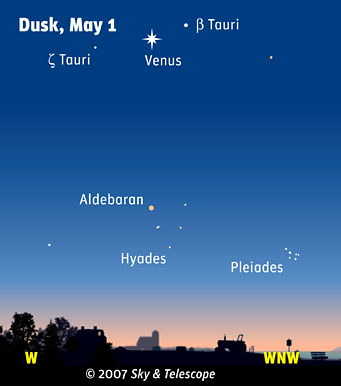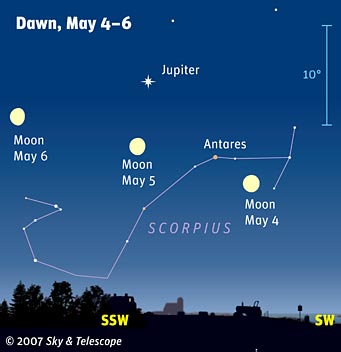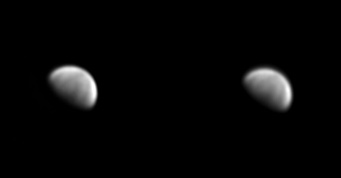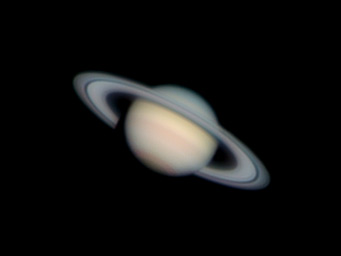Some daily events in the changing sky for April 27 – May 5.

Watch Venus pass between Beta and Zeta Tauri, the horns of Taurus, in the western sky at dusk this week.
Sky & Telescope diagram.
Friday, April 27
Try looking with binoculars or a telescope about 75 minutes before sunrise, depending on the clarity of the air. To find your local sunrise time, make sure you've put your location and current time zone into our online almanac.
Saturday, April 28
Sunday, April 29
Monday, April 30
Tuesday, May 1
Wednesday, May 2
Thursday, May 3
Friday, May 4
Saturday, May 5

The Moon passes Antares and Jupiter in the morning sky as it wanes after full. (These scenes are drawn for the middle of North America. European observers: move each Moon symbol a quarter of the way toward the one for the previous date. The blue 10° scale is about the size of your fist held at arm's length. For clarity, the Moon is shown three times actual size.)
Sky & Telescope diagram.
Want to become a better amateur astronomer? Learn your way around the constellations. They're the key to locating everything fainter and deeper to hunt with binoculars or a telescope. For an easy-to-use constellation guide covering the whole evening sky, use the big monthly foldout map in each issue of Sky & Telescope, the essential magazine of astronomy. Or download our free Getting Started in Astronomy booklet (which only has bimonthly maps).
Once you get a telescope, to put it to good use you'll need a detailed, large-scale sky atlas (set of maps; the standard is Sky Atlas 2000.0) and good deep-sky guidebooks (such as Sky Atlas 2000.0 Companion or the enchanting though dated Burnham's Celestial Handbook). Read here how to use them most effectively.
More beginners' tips: "How to Start Right in Astronomy".
This Week's Planet Roundup
Mercury is hidden in the glare of the Sun.

The clouds of Venus are essentially featureless to the eye, but they get more interesting in the ultraviolet. Sky & Telescope's Sean Walker took these stacked video images with a 12.5-inch reflector in excellent seeing before sunset on April 20, 2007. "Here are my two best results," he writes, taken 28 minutes apart. "I picked up a fused silica lens that I fashioned into a barlow — it has excellent UV transmission, though I still needed to add my Astro-Physics Barcon to achieve an acceptable image scale. Still, both together allowed a bright image at 98 frames per second."
S&T: Sean Walker
Venus (magnitude –4.1, in Taurus) is the brilliant "Evening Star" in the west during and after twilight. A few degrees to Venus's right, watch the not-quite-first-magnitude star Beta Tauri moving downward day by day.
Mars (magnitude +1.0, in Aquarius) still remains low in the east-southeast during dawn.
Jupiter (magnitude –2.5, in southern Ophiuchus) rises around 11 p.m. daylight saving time and dominates the south before dawn. Antares, less bright, sparkles 10° to Jupiter's upper right when they rise, and to its lower right by daybreak. There's a lot doing on Jupiter this season; see article. The clearest telescopic views are before and during dawn, when Jupiter is highest.

Spica (left) and the constellation Corvus (right) shine below the Moon on the evening of April 28th.
S&T: Sean Walker
Saturn (magnitude +0.4, at the Leo-Cancer border) shines high in the southwest during evening. Regulus, less bright at magnitude +1.4, is 12° to its left or upper left. North of Regulus is 2.3-magnitude Algieba (Gamma Leonis), a fine telescopic double star.
Uranus (magnitude 6, in Aquarius) is very low in the east-southeast before dawn, in the background of Mars.
Neptune (magnitude 8, in Capricornus) low in the southeast before dawn.
Pluto (magnitude 14, in northwestern Sagittarius) is not far from Jupiter in the south before dawn.
All descriptions that relate to your horizon — including the words up, down, right, and left — are written for the world's midnorthern latitudes. Descriptions that also depend on longitude (mainly Moon positions) are for North America. Eastern Daylight Time (EDT) equals Universal Time (UT, UTC, or GMT) minus 4 hours.
 0
0
Comments
You must be logged in to post a comment.